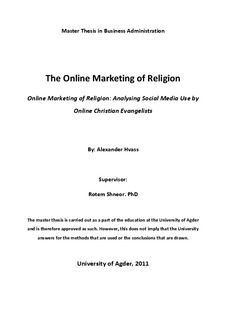| dc.description.abstract | Inspired
by
a
growing
interest
among
scholars
and
practitioners
concerning
the
promise
and
reality
of
the
Internet’s
ability
to
transform
existing
practices,
the
current
study
examines
how
evangelists
actually
use
the
Internet
in
their
evangelism
efforts.
Theoretically,
online
evangelism
is
an
emerging
new
approach
to
traditional
evangelism.
Underlying
its
emergence
are
expectations
and
initial
evidence
concerning
Internet’s
ability
to
transform
certain
aspects
of
organizations’
forms
of
promotions
(for
full
detail
see
chapter
3).
More
specifically,
this
study
engages
in
an
abductive
theory
development
effort
with
the
goals
of
discovering
the
methods
of
online
evangelism,
and
the
factors
impacting
their
particular
configurations.
In
such
a
process
analysis
proceeds
by
a
constant
interplay
between
concepts
and
data,
and
an
initial
framework
is
successively
modified
as
a
result
of
surprising
findings
or
emerging
insights
gained
along
the
analytical
process
(for
full
details
see
section
4.2).
Exploring
a
little
known
phenomenon,
best
characterized
as
a
‘moving
target’,
the
current
study
adopts
a
qualitative
research
strategy,
while
using
a
multiple
case
study
design
(see
chapter
2).
Accordingly,
5
cases
are
purposefully
selected
to
reflect
churches
of
varying
sizes
(small
to
large).
Furthermore,
an
international
dimension
is
made
possible
due
to
using
two
countries
of
origin
(USA
and
Norway),
both,
which
scored
high
on
international
e-‐readiness
rankings,
while
at
the
same
time
being
divided
by
differing
cultural
environments.
Data
analysis
follows
the
abductive
discovery
process,
where
the
researcher
is
allowed
to
be
loyal
to
ideas
and
concepts
captured
in
the
data
collected,
and
avoids
a
force
fitting
of
data
into
preconceived
frameworks.
Here,
although
an
initial
framework
is
devised,
it
only
serves
for
informing
data
collection
rather
than
serving
as
a
pre-‐defined
fixed
template.
As
the
evident
in
the
current
study,
such
openness
allowed
for
new
concepts
to
emerge,
offering
the
first
insights
into
a
little
explored
area
and
allowing
for
development
of
relevant
novel
frameworks.
The
study
concludes
with
three
models,
consisting
of
three
methods
of
online
evangelism.
The
different
methods
were
found
to
be
influenced
by
seven
variables.
The
causal
model
emerging
from
this
model
is
supplemented
by
a
list
of
propositions,
which
can
be
studied
in
future
research
projects
(see
5.3).
Implications
for
further
research
are
numerous
and
represent
both
opportunities
to
further
develop
the
current
study
with
quantitative
evaluation
of
the
concepts
and
relationships
developed
from
this
study,
as
well
as
new
ideas
and
themes
that
emerged
throughout
the
process.
This
will
help
fine
tune
the
concepts
and
framework
as
well
as
solidify
its
theoretical
base.
Finally,
the
current
study’s
quality
was
assured
by
following
the
best
practice
criteria
as
suggested
by
various
scholars
with
respect
to
both
qualitative
studies
in
general
and
case
study
research
in
particular.
Accordingly,
the
current
study
followed
practices
ensuring
credibility,
transferability,
dependability,
and
confirmability.
This
was
achieved
by
using
multiple
sources
of
data,
transparent
and
comprehensive
reporting
throughout
the
research
process,
and
engaging
in
on-‐going
consultation
with
supervisors. | no_NO |
